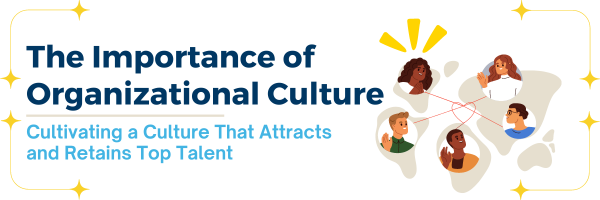The Importance of Organizational Culture: Cultivating a Culture That Attracts and Retains Top Talent
- See the World at Work The Importance of Organizational Culture: Cultivating a Culture That Attracts and Retains Top Talent

The Importance of Organizational Culture: Cultivating a Culture That Attracts and Retains Top Talent
You’ve done it! You’ve landed the perfect job at a company you’ve admired for a while. You're excited to start and can't wait to collaborate with your sharp new team members. Life is good, onboarding is smooth, and everything seems to be falling into place. But then, something unsettling happens. Maybe it's an odd question from your new supervisor or some strange behavior in the team chat. You feel a bit uncomfortable, but you brush it off, thinking you might be overreacting or that it was just a glitch.
Fast forward six months, and nothing has changed. Is there anything worse than finding out your ideal job is located in a toxic work culture? No.
So business leaders we have to ask: Is there anything more important to attracting and maintaining transformational staff than your organization’s culture? Let’s talk about it!
In today's competitive business landscape, the significance of organizational culture cannot be overstated. A company's culture shapes its identity, drives employee engagement, and influences overall performance. A strong, positive culture can attract top talent, foster innovation, and ensure long-term success. In this article, we will explore the importance of organizational culture and provide a guide for cultivating a culture that attracts and retains transformational talent for years to come.
Why Organizational Culture Matters
- Attracts Top Talent: A compelling company culture serves as a magnet for top-tier talent. Candidates are increasingly prioritizing workplace culture when choosing where to apply and accept job offers. A positive culture not only attracts skilled professionals but also aligns them with the company's values and mission.
- Enhances Employee Engagement: Employees who resonate with their company's culture are more likely to be engaged and motivated. Engagement leads to higher productivity, better performance, and lower turnover rates. Engaged employees are also more likely to become brand ambassadors, promoting the company to potential hires.
- Drives Innovation: A culture that encourages creativity and risk-taking fosters innovation. When employees feel safe to express their ideas and challenge the status quo, they contribute to the development of new products, services, and processes that can set the company apart from competitors.
- Builds a Strong Brand: Organizational culture is a key component of a company's brand identity. A well-defined culture can enhance the company's reputation, attract customers, and build loyalty. It communicates the company's values, ethics, and commitment to excellence.
- Ensures Long-Term Success: Companies with strong cultures are better equipped to navigate challenges and adapt to change. A resilient culture can help maintain stability during times of crisis and drive sustained growth.
A Guide to Cultivating a Transformational Culture
- To build and maintain a culture that attracts and retains top talent, organizations must be intentional and strategic. Here are key steps to cultivating a transformational culture:
- Define Core Values and Mission: Clearly articulate the company's core values and mission. These should reflect the principles and goals that guide the organization's actions. Ensure that every employee understands and embraces these values.
- Lead by Example: Leadership plays a crucial role in shaping and maintaining culture. Leaders should embody the company's values in their actions and decisions. By demonstrating commitment to the culture, leaders set the standard for the rest of the organization.
- Foster Open Communication: Encourage transparent and open communication at all levels. Create channels for employees to share feedback, ideas, and concerns. Regularly communicate the company's goals, achievements, and challenges to keep everyone aligned and informed.
- Promote Inclusivity and Diversity: Cultivate an inclusive environment where diversity is valued and respected. Diverse teams bring different perspectives and ideas, leading to better decision-making and innovation. Implement policies and practices that promote equity and inclusion.
- Invest in Employee Development: Offer opportunities for professional growth and development. Provide training, mentorship, and resources to help employees advance their careers. A culture of continuous learning not only enhances skills but also demonstrates the company's commitment to its employees' success.
- Recognize and Reward Contributions: Acknowledge and celebrate employees' achievements and contributions. Recognition can be formal, such as awards and bonuses, or informal, such as verbal praise and thank-you notes. Regularly recognizing efforts fosters a sense of appreciation and motivation.
- Create a Positive Work Environment: Design a work environment that promotes well-being and productivity. This includes physical spaces that are comfortable and conducive to work, as well as policies that support work-life balance, such as flexible hours and remote work options.
- Encourage Collaboration and Teamwork: Build a culture of collaboration where teamwork is encouraged and rewarded. Create opportunities for employees to work together on projects, share knowledge, and support each other. Collaboration enhances problem-solving and fosters a sense of community.
- Regularly Assess and Evolve Culture: Continuously evaluate the company's culture to ensure it remains aligned with its goals and values. Gather feedback from employees through surveys and discussions, and be open to making adjustments as needed. A dynamic culture that evolves with the organization is more likely to stay relevant and effective.
Conclusion
A strong organizational culture is a vital asset that can attract top talent, drive engagement, and ensure long-term success. By being intentional about defining, cultivating, and maintaining a positive culture, companies can create an environment where employees thrive and transformational talent is drawn and retained. Investing in culture is not just a business strategy; it's a commitment to building a sustainable, high-performing organization for years to come.
Related Content




Comments